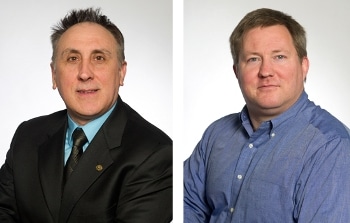Jul 1 2016
A faster and more precise method to evaluate gravitational wave signals and deduce the astronomical sources from which they were made has been developed by professors at Rochester Institute of Technology.
 Carlos Lousto and Richard O’Shaughnessy (Credit: Rochester Institute of Technology)
Carlos Lousto and Richard O’Shaughnessy (Credit: Rochester Institute of Technology)
This method compares data from the Laser Interferometer Gravitational-wave Observatory directly to the advanced numerical simulations of binary black holes, together with simulations conducted at RIT.
The LIGO Scientific Collaboration analyzed the initial gravitational wave detections with this method and their results have been published online. Detailed analyses of these simulations prove that the first detected black holes were to some extent similar in mass than thought before. Richard O’Shaughnessy, Manuela Campanelli, Carlos Lousto, John Whelan and Yosef Zlochowe, faculty; postdoctoral researcher James Healy; graduate students Jacob Lange and Yuanhao Zhang; and undergraduate student Monica Rizzo and recent graduate Jackson Henry are the authors of this paper from RIT. All of them are part of RIT’s Center for Computational Relativity and Gravitation and the LIGO Scientific Collaboration.
It is the first time numerical simulations of binary black holes are used directly to estimate the parameters of a binary and, in this paper, it is proved that this can be done to the highest accuracy.
Lousto
Lange, a Ph.D. student in RIT’s astrophysical sciences and technology graduate program, is conducting a validation study of this method.
Our approach compares waveforms directly to numerical relativity simulations to reanalyze the first gravitational wave detection.
Lange
Lange’s study supports Lousto and O’Shaughnessy’s efforts to improve a new gravitational wave-data pipeline by making use of targeted simulations. O’Shaughnessy explained his work previously at the Gravitational Wave Physics and Astronomy Workshop in Cape Cod, Mass.
Most of the interesting information arrives at the end where the black hole does its most wild motions and all the cool physics of Einstein’s theory really comes to the fore. We think by simulating the most interesting part and attaching the simple part, we’ll be able to do some really interesting science that is not possible any other way.
O’Shaughnessy, Assistant Professor, RIT’s School of Mathematical Sciences
Researchers at RIT played a vital role in the LIGO Scientific Collaboration’s milestone discovery. The simulated signal alone confirmed the observed waveform that was formed by the black hole merger and this helped verify Einstein’s general theory of relativity. This work reveals the function of simulated signals in the study of gravitational waveforms.
“These simulations are what we have leveraged for all these years to get all the insight we have about how black holes merge and their gravitational radiation,” said O’Shaughnessy. “They are the most complete and accurate models of binary black-hole coalescence.”
Black holes simulations with various spins and masses that match, or which are unusually aligned, necessitate the complicated Einstein’s strong field equations math. O’Shaughnessy collaborated with Lousto, who is an expert in the numerical relativity field and simulates black holes situations on supercomputers.
Simulations are used to extract details regarding the black holes’ properties from the gravitational wave data directly. On the other hand, the primary analyses of the first gravitational waves used approximations derived from earlier simulations to comprehend.
“Richard’s method allow us to avoid the intermediate step and is faster and more accurate,” stated Lousto, Professor, RIT’s School of Mathematical Sciences and fellow of the American Physical Society. “The method always improves itself because with every new simulation, it adapts. It can only get better.”
Lousto’s simulations uses the computational techniques from the 2005 milestone study, which he conducted along with Campanelli, Director, RIT’s Center for Computational Relativity and Gravitation and a member of the LIGO Scientific Collaboration, and Zlochower, Associate Professor, RIT’s School of Mathematical Sciences.